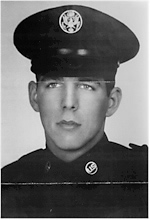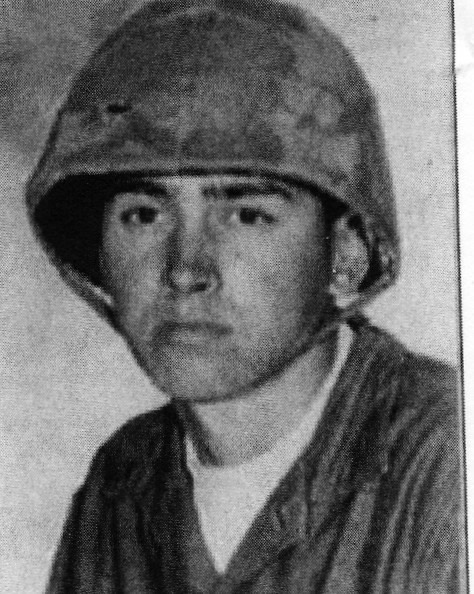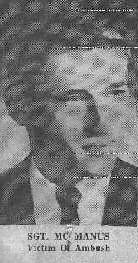
PETER R CRESSMAN - SGT
- HOMETOWN:
- wayne
- COUNTY:
- Passaic
- DATE OF BIRTH:
- May 23, 1951
- DATE OF CASUALTY:
- February 05, 1973
- BRANCH OF SERVICE:
- Air Force
- RANK:
- SGT
- STATUS:
- RR
- COUNTRY:
- LAOS
Biography
Peter Richard Cressman was born May 23, 1951. His home of record is Wayne, NJ.
He entered the US Air Force in August 1969, and spent two years at Elmendorf Air Force Base in Anchorage, AK. He attained the rank of Sergeant (SGT).
Cressman volunteered for service in Vietnam and arrived at Da Nang in June 1972. He was originally assigned to Detachment 2, 6994th Security Squadron, Da Nang. He was later transferred to Detachment 3, 6994th Security Squadron from Ubon, Thailand. The men from this unit were highly trained and operated in the greatest of secrecy. They were cryptology experts, language experts and knew how to operate some of the Air Force's most sophisticated equipment.
He was the systems operator on an EC-47 aircraft, flying an operational mission, when on February 5, 1973, about a week after signing the Paris Peace Agreement, his aircraft was shot down over Saravane Province, Laos, about 50 miles east of the city of Saravane.
On February 22, 1973, he was declared killed in action, when evidence of death was received in the Department of the Air Force and his remains were shortly thereafter repatriated.
Cressman's remains were repatriated on February 9, 1993, and positively identified on October 27, 1995, using a piece of molar received from the crash site. A bridge over the Ramapo River in Oakland, New Jersey was named and dedicated to Peter Cressman.
Synopsis (from the POW Network) as to the circumstances behind being listed as MIA:
On February 5, 1973, about a week after the signing of the Paris Peace Agreement, an EC47Q aircraft was shot down over Saravane Province, Laos, about 50 miles east of the city of Saravane. The crew of the aircraft consisted of the pilot, Capt. George R. Spitz; co-pilot, 2Lt. Severo J. Primm III, Capt. Arthur R. Bollinger, 1Lt. Robert E. Bernhardt, Sgt. Dale Brandenburg, Sgt. Joseph A. Matejov, all listed as crew members, and Sgt. Peter R. Cressman and SSgt. Todd M. Melton, both systems operators. The families of all aboard the aircraft were told the men were dead, and advised to conduct memorial services.
It is known that Cressman and Matejov were members of Detachment 3, 6994th Security Squadron from Ubon, Thailand. The aircraft, however, was flying out of the 361st TEW Squadron (Tactical Electronic Warfare Squadron) at Nakhon Phanom Airbase, Thailand. Primm, Melton, Spitz, Brandenburg and Bernhardt were assigned to the 361st TEW Squadron. Bollinger's unit is unknown.
The men in the 6994th were highly trained and operated in the greatest of secrecy. They were not allowed to mingle with others from their respective
bases, nor were the pilots of the aircraft carrying them on their missions always told what their objective was. They were cryptology experts, language experts, and knew well how to operate some of the Air Force's most sophisticated equipment. They were the first to hear the enemy's battle plans.
Over five years later, Joe Matejov's mother, Mary Matejov, heard columnist Jack Anderson, on "Good Morning America", describe a Pathet Lao radio communique which described the capture of four "air pirates" on the same day as the EC47Q carrying her son was shot down. NO OTHER PLANE WAS MISSING THAT DAY. Anderson's information indicated that reconnaissance personnel had 40 uninterrupted minutes in which to survey the crash site.
The report of the reconnaissance team, which was not provided to the families for over five years, showed that three bodies, which were thought to have been higher ranking officers because of the seating arrangement, were found strapped in seats. Four of the men aboard the aircraft were not in or around the aircraft, and the partial remains of the eighth man (Bernhardt) was recovered. No identification was brought out from the crash site, and no attempt was made to recover the three bodies from the downed aircraft. It is assumed that the reconnaissance team was most interested in recovering the sensitive equipment aboard the EC47Q. The EC47Q became known as the "Flying Pueblo". Most of the "kids" in back, as some pilots called them, were young, in good health, and stood every chance of surviving captivity.
There were specific reports intercepted regarding the four missing men from the aircraft missing on February 5, 1973. Radio reports indicated that the four were transported to the North Vietnam border. None were released in the general POW release beginning the next month.
Peter Cressman enlisted in the United States Air Force in August 1969, and after two years at Elmendorf AFB in Anchorage, Alaska he volunteered for service in Vietnam and left for Da Nang in June 1972.
In Da Nang, Peter spent his free hours at Sacred Heart Orphanage. His letters to his hometown priest in Oakland, New Jersey, resulted in the forming of "Operation Forget-Me-Not". Community schools, churches, merchants and citizens joined the effort to help the innocent victims of war. The group eventually provided a boxcar of supplies to the orphans.
Peter was transferred to the airbase at Ubon, Thailand. He believed the secret missions being flown into Laos were illegal, and had written letters to his congressman in that regard. His family has been active in efforts to locate information on Peter and the nearly 2500 others who remain
unaccounted for. They founded the National Forget-Me-Not Association for POW/MIAs in St.Petersburg, Florida, the largest POW advocacy group in the country.
Sources: Tom Crowley (former roommate), Fred Kohmuench (veteran), the POW Network and NJVVMF.
Remembrances
Be the first to add a remembrance for PETER R CRESSMAN
Help preserve the legacy of this hero, learn about The Education Center.
LEARN MORE

